This post may contain affiliate links. We may receive a small commission, at no cost to you, if you make a purchase. Read Disclosure.
Bangkok is the most visited city in the world, receiving 32 million visitors in 2024, all mingling together with its 17.4 million permanent residents – so with all these people, how to you navigate the city?
Getting around Bangkok can be incredibly challenging if you’ve never been to the city before. While there is a metro and a Skyrail service, many of the city’s neighborhoods are not serviced by Bangkok’s public transportation system, so it’s important to be clued up on the route maps and how it works, so you can get from A to B without a hitch.
With trains, buses, subways, boats, sky trains, taxis, tuk-tuks, and your own two feet, this guide will help you understand which public transport to take and to where.
We’ve detailed each mode of transport in Bangkok so you can navigate your way around Bangkok’s mass transit system without a hitch.
Types of Public Transportation in Bangkok
From the Bangkok airport rail link, to subways and tuk-tuks there are so many options for getting around Bangkok. Here’s some information on each way around Bangkok, Thailand.
1. Bangkok Airport Rail Link & Rangsit Rail Link Express
I don’t really get excited to travel on trains, but I was when I took the Bangkok Airport Rail Link. Not because it was a train, but because it was exactly the solution I needed when getting to and from the airport.
I loved not having to worry about expensive airport parking, over-priced train fares (the Sydney airport link is extortion), slow buses, expensive cabs, or dirty public transport in general.
The Bangkok Airport Rail Link is cheap, clean, and efficient and gives you the chance to watch greater Bangkok pass by your window.
The airport link opened in 2010 and connects Suvarnabhumi Airport (BKK), to the city center of Bangkok. From Bangkok’s other airport, there is another Rail Link service, called the Rangsit, which connects Don Mueang International Airport to the city centre.
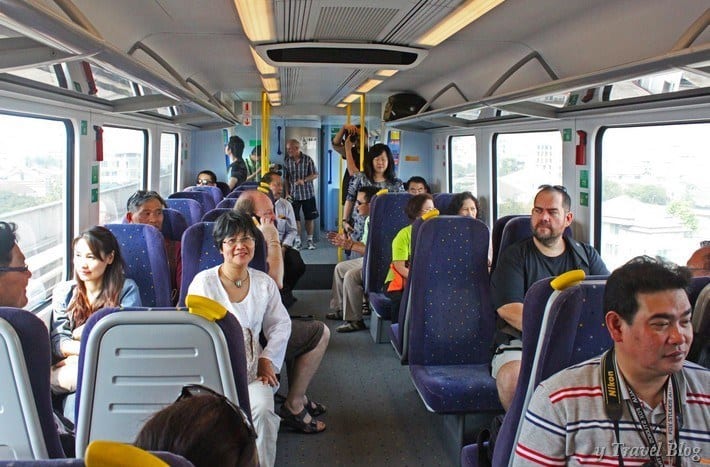
From Don Mueang International Airport
To get to the city centre from Don Mueang International Airport, you can take the train from the airport to Mo Chit Station, and then connect either onto the BTS Station (Skytrain) or the MRT metro, depending on where you are staying in Bangkok.
The BTS takes roughly 20-30 minutes to get to the Siam Area, and the MRT takes about 30-40 minutes.
From Suvarnabhumi Airport (BKK)
Suvarnabhumi Airport is the main international airport in Bangkok, and so it’s likely you will fly in or out of this airport.
The train to/from Suvarnabhumi Airport will go directly from either Makassan Station or Phaya Thai Station.
Phaya Thai has an easy connection to the BTS sky train and Makassan is within walking distance of the Phetchaburi MRT station on the Sukhumvit Line, so you can easily jump onto other public transport to get to your hotel.
At Makassan station, you can check in for a Thai Airways flight. If you have an evening flight, check your luggage in and then go hang out in the city until you need to go to the airport. Cool idea!
You do not need to book your rail ticket in advance, just rock up at the station and buy a ticket from the booth. Staff speak great English and are there to help!
If you want to save a little more money and have a bit more time, then take the City Line to Suvarnabhumi Airport. Trains run every 15 minutes, there are six stops and it takes 35 minutes to get to the airport on this line.
2. Bangkok Taxis
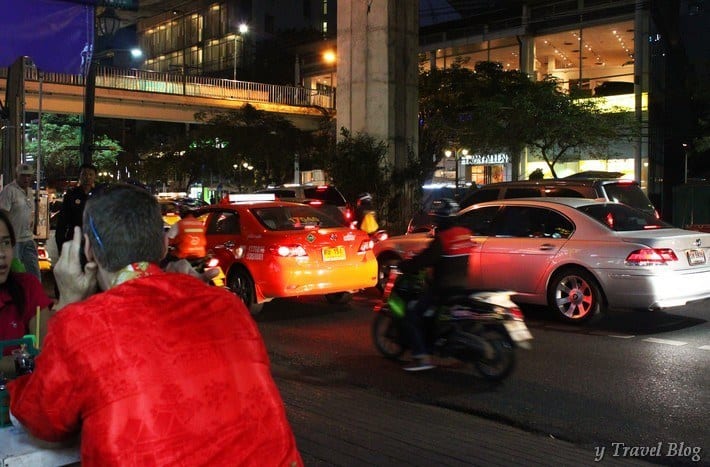
Unless it is very early in the morning or late at night, I wouldn’t even consider getting a taxi in Bangkok. The traffic is notoriously bad and it will end up costing you a lot.
A metered cab to the airport will cost from 200-400 baht depending on traffic. If you take the tollway (which in Bangkok traffic you should) then you will pay an extra 45-50 baht for the toll.
When getting around Bangkok, a taxi should always be a last resort. They are slow and expensive, and you spend most of your time sitting in traffic. Unless you’re getting motorbike taxis that whizz between the cars.
Always insist that the meter is turned on when you enter a Bangkok taxi. Be aware that if you take one within Bangkok you will have to deal with added costs due to traffic delays and have to pay for every toll.
All taxis are now metered and air-conditioned: the hailing fee is 35 baht for the first two kilometres and 2 baht per kilometre after that. Most trips in downtown cost less than 100 baht.
To avoid confusion have the name of your destination written in Thai when asking your driver to take you somewhere.
3. Ride-share apps (Grab and Bolt)
If you are worried about prices racking up with taxis, and need to get somewhere fast, use the ridesharing taxi app, Bolt. This is the Uber of Thailand and has much cheaper prices than Uber.
Grab is another app you can use, which is better for if you are hailing cars, but Bolt is better if you need a motorbike. Bolt is usually cheaper than Grab and Uber too.
If you’re traveling by yourself, you can take a Bolt motorcycle taxi to anywhere in the city, and it will tell you the cost of the fare at the beginning of your trip, so you can just pay the fare in cash when you reach your destination.
The benefit of a Bolt bike is you can whizz between the traffic, but it can also be quite unnerving if you’re not used to bikes. Make sure you ask your driver for a helmet! They usually have a spare one, but usually the driver won’t offer it to you unless you ask.
Motorcycles are fun, but can be dangerous.
4. Bangkok MRT Subway
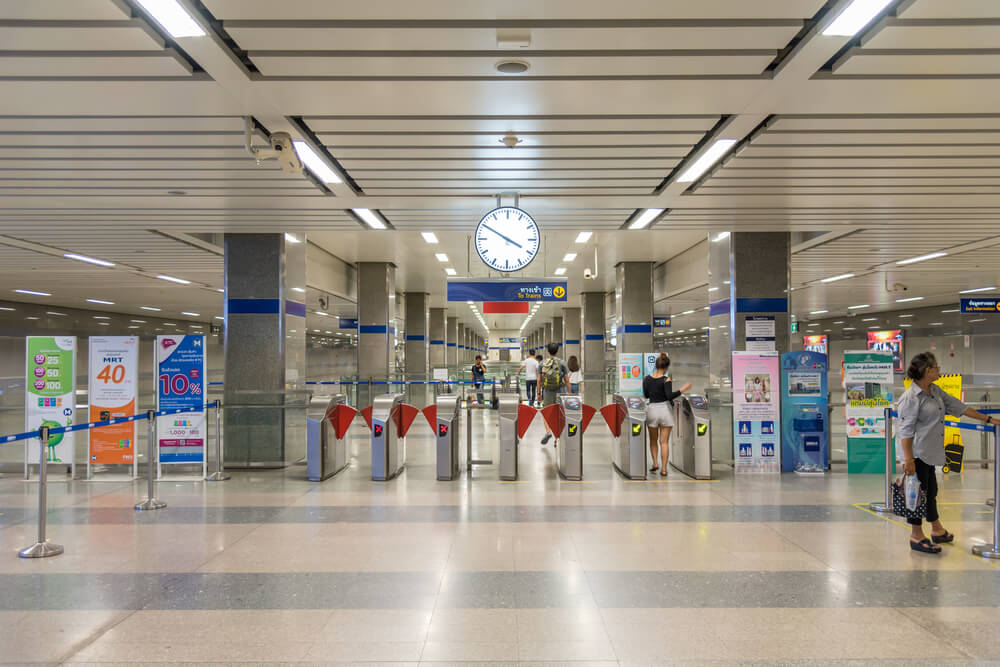
The Bangkok MRT is the underground subway network in Bangkok. It’s clean and efficient and has reasonable prices (certainly cheaper than taxis).
The MRT is really easy to navigate since there are only four lines serving 107 stations in Bangkok. The lines are colour-coded; blue, purple, yellow and pink, but the blue line would be the one you would use more as a visitor as it connects the main attractions in downtown.
The blue line takes a circular route around the city, the purple, pink, and yellow lines tends to operate more in residential areas.
The interchange station between the blue and purple lines is Tao Poon Station, which you’ll only really use if going to the Chatuchak Weekend Market. Most likely you will stay on the blue line the whole time.
Bangkok MRT subway trains run every 5-7 minutes and connect to BTS at Sukhumvit and Silom stations, as well as several other BTS stops, so you can easily swap between the two modes of transport.
Commuters can buy single trip tokens (16 to 45 baht depending on the distance). The MRT doesn’t offer day passes, you have to pay per trip, unlike the BTS.
Note: The MRT and BTS Sky Train are two separate companies, so you will need to buy tickets for each separately. It’s a good idea to plan your daily public transportation in Bangkok to see which mode of transport you use more. If you use the BTS more, it’s worth investing in a day pass. More on this below.
5. The BTS Skytrain
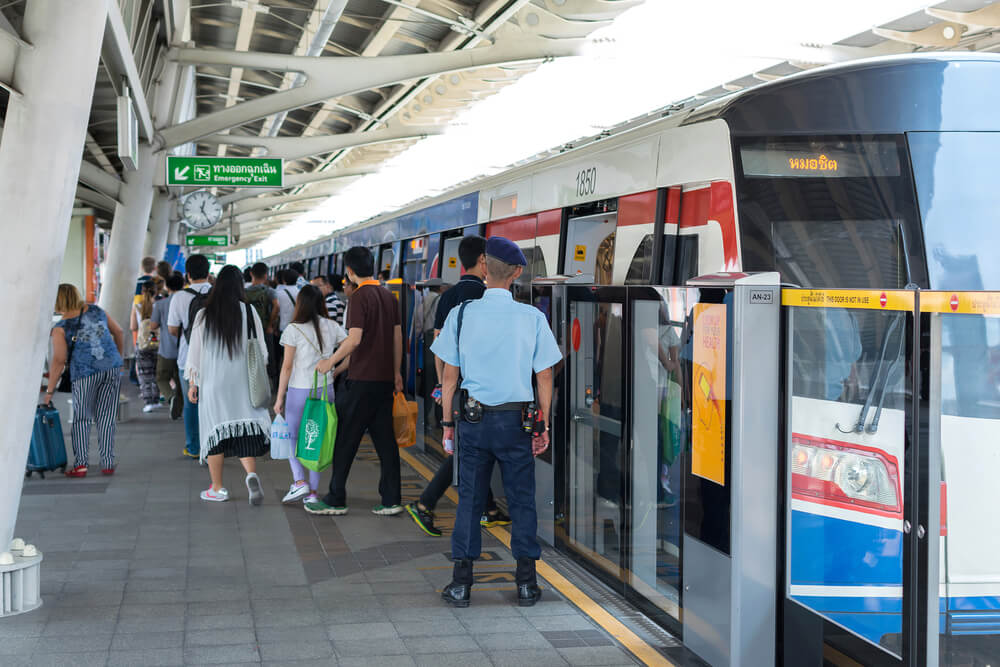
The BTS Sky Train is an excellent way of getting around Bangkok. In fact, it’s probably one of my favourite public transportation in Bangkok because it’s clean, quick, air conditioned, and you get to watch the city go by.
You will really appreciate it on a stinking hot day as the AC is freezing! The sky train can get you around Bangkok quite quickly, but it does not connect everywhere in the city.
The BTS was constructed in 1999 and while it has been extended since, it still does not reach too many places in Bangkok. It does not reach Bang Phlat across the Chao Phraya River, for example.
It’s easy to navigate as it only has two lines, the Sukhumvit Line and the Silom Line.
When visiting many tourist attractions in Bangkok, you will most likely need to take the BTS and the MRT or taxi to your destination. The MRT also has a BTS Skytrain Station at Sala Daeng, Asok, and Mo Chit.
The BTS Sky Train covers most of downtown Bangkok however and is a good option if you are going a short distance. Fares range from 15 to 62 baht depending upon how many zones you are travelling in.
Consider the Rabbit Card, a rechargeable stored-value card (from 100 baht for the card plus the cost of your journey), or one day pass for 150 baht per day.
The Rabbit Card may be worth getting if you are visiting Bangkok for more than a few days.
6. Tuk Tuks
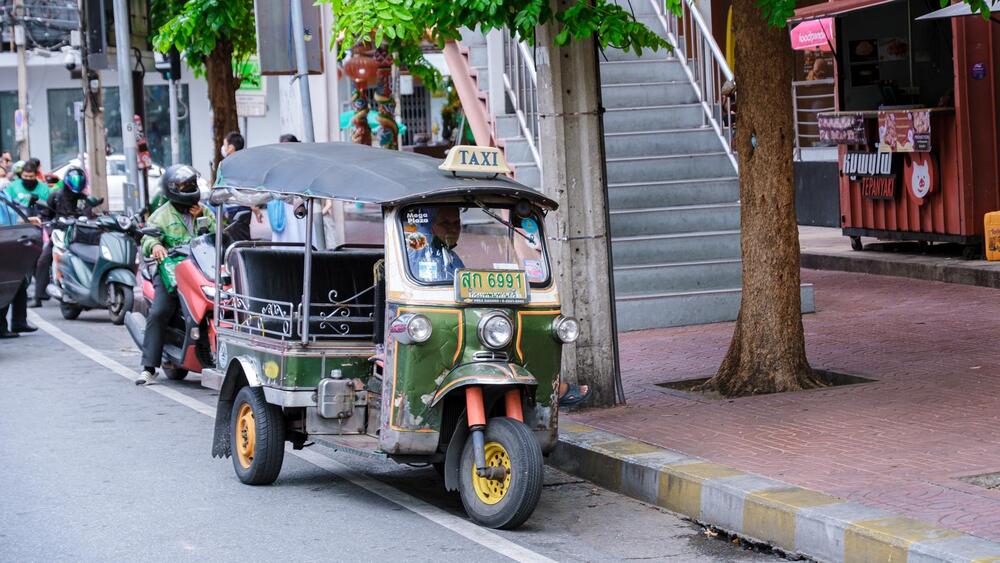
Tuk tuks are one of my favourite ways of getting around Bangkok, despite being a bit of a tourist gimmick and you spend the whole ride on the edge of your seat and with a face full of pollution.
The great thing about tuk-tuks is they are everywhere. There are many places the Bangkok rail network will not reach. In that case, you have to take a bus, walk, or a taxi, or tuk-tuk.
Even though tuk tuks are more expensive than a Bolt would be, I would often opt for them just for the thrill of it.
Riding a tuk tuk will involve bartering before you start your journey. There is no set price for a tuk tuk.
Tuk Tuk drivers will always try to overcharge the tourists. Offer the price you are willing to pay and see what they say. If they say no, walk away and take a Bolt instead.
If they follow you, you know that your price was reasonable, and barter a little more to meet in the middle.
I was fortunate enough to be an English teacher and know a little Thai, so before I would start the negotiation in Thai.
Pro tip: If you speak a little Thai, you will likely get a much more favorable price because you’ve made an effort to speak in their language. Kindness and respect go a long way in Thailand.
7. Bangkok Buses
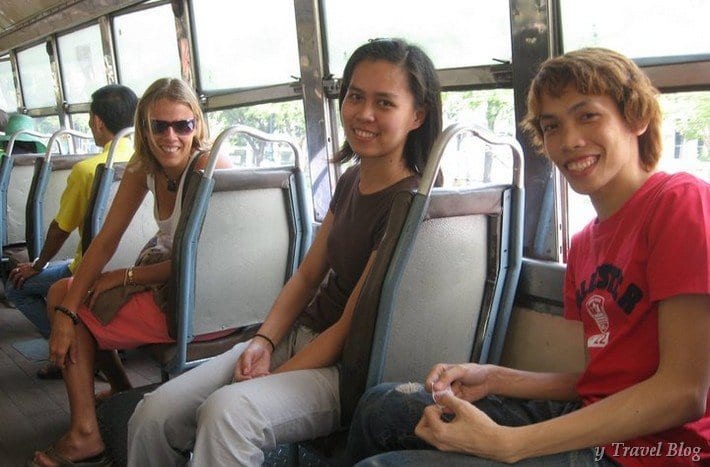
The buses in Bangkok are often the most convenient way around the city as there are usually several buses that go to the top attractions.
The bus is the cheapest form of transport, and usually only costs a few baht, ranging from 8-15 baht per journey. The price of buses depends on their colour and how far you go.
However, it’s not always easy to know which bus to catch or what route you need to take. The ViaBus App is great as it shows all the buses, the route they take, AND where the bus is! So you know how long you are waiting for.
We loved getting around Bangkok on a bus. The constant clacking of the conductor’s change tin as he tried to wriggle his way through the sweaty armpits of all of Bangkok squashed into the bus is a memory that will last forever.
Hold your nose, hold on tight, and watch out for potholes. Hold the overhead hand ropes or the person next to you and enjoy the cultural experience.
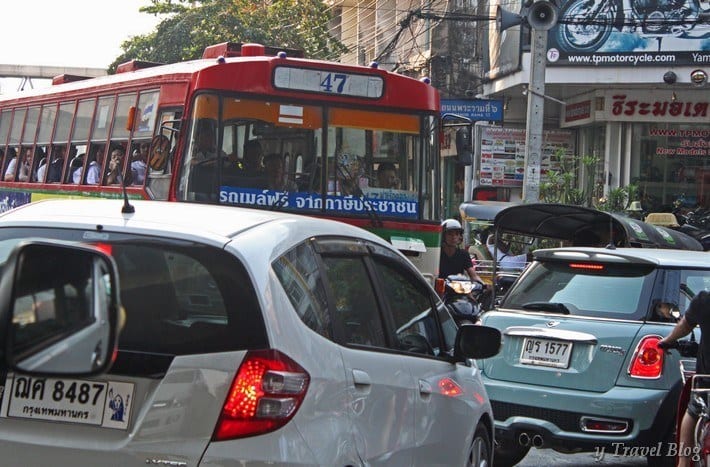
Although they are a very cheap way of getting around Bangkok, there are some downsides. Most are not air conditioned – if you get a really old unairconditioned bus with just a fan, you usually pay the cheaper fare of only 8 baht per journey – and they take a long time to reach your destination.
Buses do get stuck in traffic jams. An off-peak drive would take 15 minutes, but during those heavy periods, it can be an hour to an hour and a half.
The bus is the cheapest but slowest form of public transportation in Bangkok.
8. River Taxis/Ferries, and Long-Tail Boats
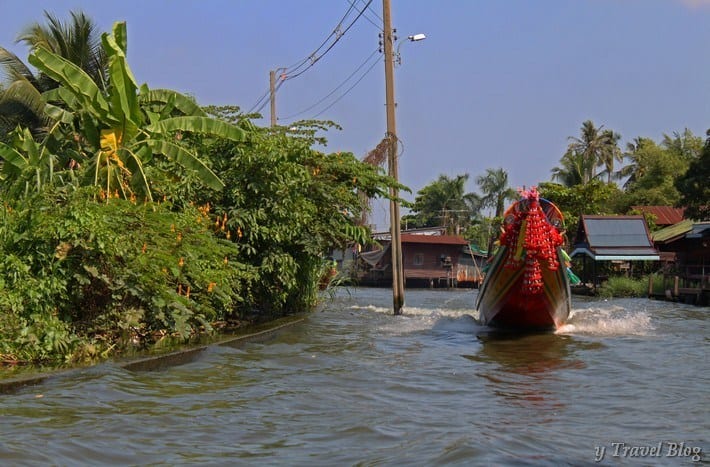
A cheap and unique way to get around Bangkok and see the more suburban side of it is by river boat.
The Khlong Saen Saep Express Boat is mostly used by commuters and goes down one of the few remaining klongs (canals). It provides easy access from the Golden Mount (our old home and close to Khao San Road) to Siam Square.
The fare is 8-20 baht depending on where you want to go to. Watch your step getting on and off!
The Chao Phraya Express boat is more of a tourist boat, as it runs along the river stopping off at many tourist spots such as Wat Arun. I love exploring Bangkok from the river boats.
These boats go from Phra Arthiti pier near Khao San Road. The Chao Phraya Express Boat is more expensive, ranging from 16-33 baht per trip. It depends which route you take and how far you go.
The orange line is the one that covers most tourist destinations and is fast. They are also slightly more comfortable as fewer locals use them, and cost a flat rate of 16 baht.
If you want to get around the klongs and see the floating markets, then you may want to hire a long-tail boat. You can hire a long-tail boat from many piers in Bangkok, but the most popular is Phra Arthiti pier near Khao San Road.
Alternatively, get an MRT or BTS to Bang Wa Station and take a taxi. You can also get a BTS directly to Sathorn Pier.
9. Walking Around Bangkok
There is so much to discover and explore in Bangkok, but it’s also huge, so walking is not really an option unless you stay in one neighborhood.
If you want to visit the Grand Palace and Wat Pho, as well as the other temples in Old Town, it’s really easy to walk from one to the other.
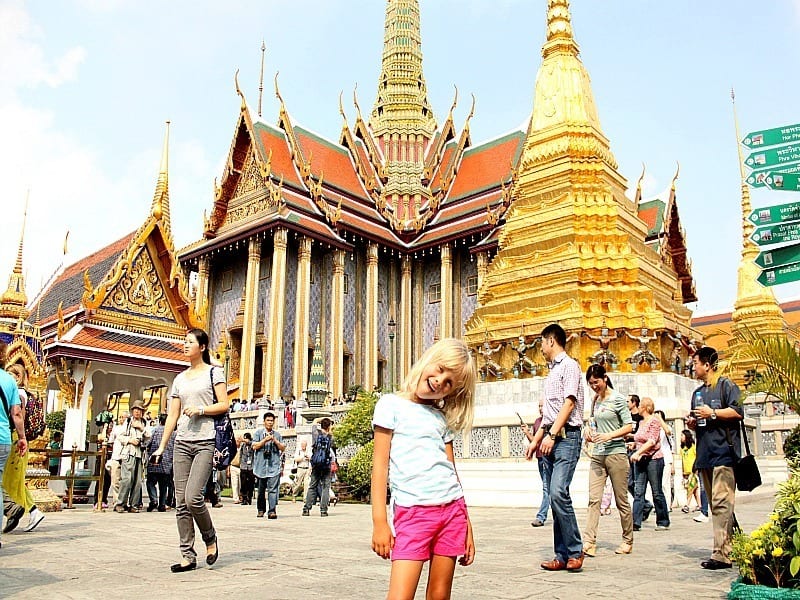
Likewise, when visiting Chinatown, the neighborhood spans three MRT stations, but you can easily walk from one side to the other in 30-40 minutes or so.
Where possible, opt to walk instead of taking one or two stops on the MRT or BTS. It won’t cost you anything and has less impact on the smog that shrouds the city every day.
Most of the time walking is quicker than riding one or two stops, and more peaceful than dealing with the horrors of Bangkok traffic.
Where to stay in Bangkok
Because Bangkok is such a huge city and everything is spread far and wide, wherever you choose to stay, be sure to base yourself near to a metro station or BTS station.
For those who are travelling on a budget, we recommend the Sukhumvit neighborhood, which has both a BTS and Metro. The Chateau de Sukhumvit hotel sits on a wonderful street where ex-pat bars intermingle with hawker food stalls.
For a much more polished 5- star experience, there is no better place to stay than the Sheraton Grand Sukhumvit.
It sits across the famous Benchakitti Park and Lumpini Park. Not only is the park a wonderful place to spend the day as a family, but the hotel is also a 5 minute walk from our top shopping mall, Terminal 21, where you can find affordable and delicious food in Bangkok.
There are plenty of vacation rentals options, and if this is the route taken, it’s best to get one a bit outside the city to have the opportunity for a more authentic and local experience.
Before You Go
Bangkok is an energetic city with so much happening all the time. It’s busy, chaotic, and wild – but that’s all part of the fun of it!
Hopefully, this guide has helped you understand Bangkok’s public transportation a little better and give you some options. Be sure to put your itinerary together first, so you can plan which of Bangkok’s public transportation you need to take.
Before you go, be sure to download maps and all your relevant apps, so you can get from A to B as soon as you arrive at the airport.
When walking, be careful of traffic. The pedestrian light may say green, but cars will still go. Always look when crossing the road and be careful of rogue drivers!
Popular Tours of Bangkok
How do you feel about getting around Bangkok? Let us know if you have any questions in the comments!


